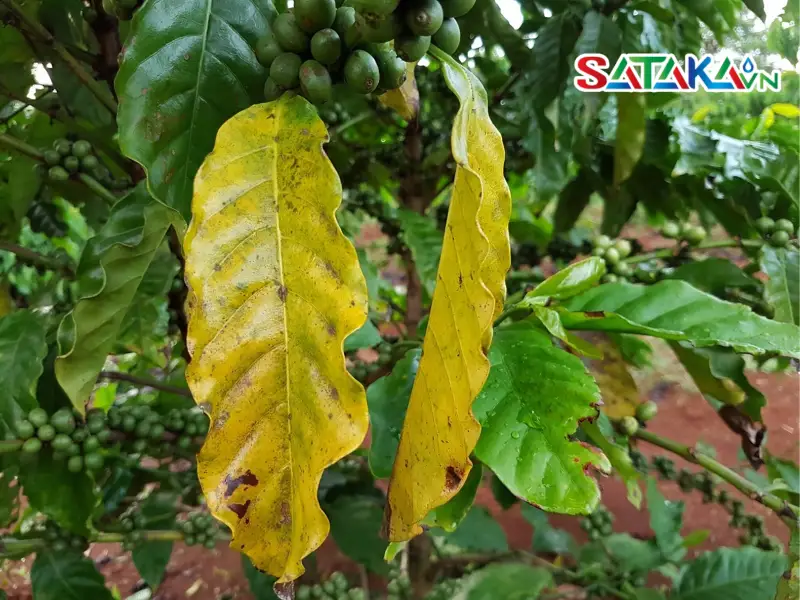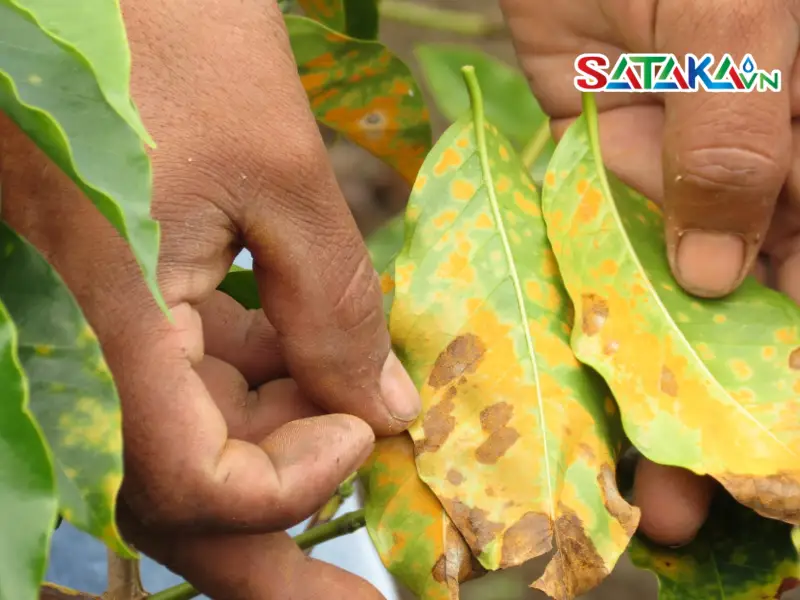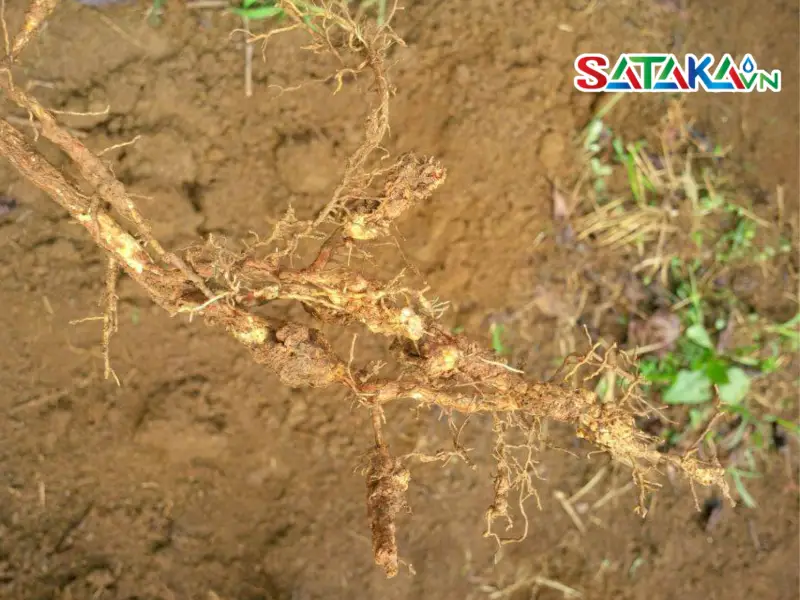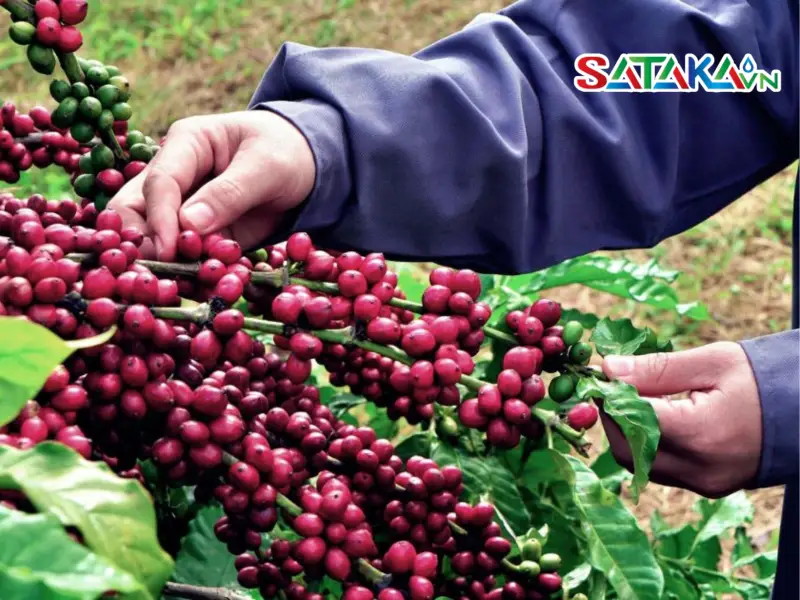Overcome the problem of yellow coffee leaves effectively with quality products from Sataka. Ensure healthy plants, high productivity and effective disease prevention.
Yellowing of coffee leaves is a common issue faced by many coffee growers. This phenomenon not only affects the plant's appearance but also reduces yield and harvest quality. Understanding the symptoms, causes, and preventative measures is crucial for protecting coffee plants from this condition. In this article, Sataka provides detailed information about coffee leaf yellowing to help you identify and effectively address this issue in your coffee garden.
Coffee leaf yellowing can result from various physiological factors. One of the primary causes is the deficiency of essential nutrients such as nitrogen, phosphorus, potassium, iron, and zinc. These nutrients play an important role in photosynthesis and plant growth, and their deficiency leads to yellowing leaves and weakened plants.

Coffee tree leaves turn yellow
Nutrient competition with other plants is also a significant factor. When coffee plants are grown near other crops or on overused soil, nutrient competition can prevent the coffee plants from receiving adequate nutrition, causing yellowing.
Adverse weather conditions such as drought, waterlogging, or prolonged rain can also contribute to leaf yellowing. These factors can alter soil pH, reduce nutrient absorption, and result in yellowing leaves.
Pests and diseases are common causes of coffee leaf yellowing. Nematodes attacking the roots can damage the plant's root system, reducing its ability to absorb water and nutrients, leading to yellowing leaves.
Root fungi infections also cause coffee leaf yellowing. These fungi impair root function, stunting plant growth and causing the leaves to turn yellow.
Additionally, leaf-eating insects contribute to yellowing by damaging the leaves, reducing photosynthesis, and weakening the plant.
Beyond physiological and pest-related issues, other factors can cause leaf yellowing. Acidic, saline, or alkaline soils can reduce nutrient absorption, leading to yellowing.
Improper garden management, such as over-fertilization or incorrect watering, also causes leaf yellowing. Excess fertilizer can lead to nutrient imbalances, while improper watering can either increase or decrease soil moisture, affecting plant growth.
When coffee plants experience yellowing leaves, the symptoms often appear clearly and affect multiple parts of the plant. Common symptoms include:
On Branches and Leaves: Yellowing leaves are accompanied by slow plant growth, wilting, and drying branches. Affected plants may appear stunted and fail to develop normally. Yellowing is particularly noticeable at the beginning of the dry season, especially after the rains have stopped and before irrigation begins. In severe cases, the plant may dry out, drop leaves, and eventually die.

Symptoms of coffee tree leaves turning yellow
On Roots: Symptoms include blackened feeder roots, and in severe cases, even the main roots may rot and break. Damaged roots make the plant prone to toppling during strong winds. As roots decay, the plant's ability to absorb nutrients is compromised, ultimately leading to plant death.

The tree shows bad symptoms in the roots when it has yellowing leaves
Use Disease-Resistant Coffee Varieties: Selecting disease-resistant coffee varieties reduces the risk of leaf yellowing. These varieties can withstand harmful agents, ensuring healthier plant growth.
Pre-Planting Soil Treatment: Treating the soil before planting eliminates pathogens and nematodes that could harm coffee plants. Ensure the soil is clean and well-structured to provide an ideal environment for plant development.
Balanced and Appropriate Fertilization: Balanced fertilization supplies essential nutrients to coffee plants. Ensure the provision of macronutrients, secondary nutrients, and micronutrients to avoid nutrient deficiencies.
Proper Irrigation Techniques: Correct irrigation maintains appropriate soil moisture for plants. Avoid overwatering or underwatering to reduce the risk of yellowing due to unfavorable weather conditions.
Clean Garden Maintenance: Regularly clean the garden to eliminate potential disease sources and prevent the spread of diseases. Remove fallen leaves, branches, and plant debris to reduce the risk of infections.

Disease prevention for coffee plants
Supplement Missing Nutrients: If yellowing is caused by nutrient deficiencies, supplement the missing nutrients. Using organic or bio-fertilizers not only provides nutrients but also improves soil structure and promotes plant growth.
Apply Appropriate Pesticides and Fungicides: To control pests, fungi, and nematodes, use specialized pesticides, fungicides, or nematicides. Choose safe and effective products and follow application instructions to protect both the plants and the environment.
Adjust Irrigation to Improve Soil Conditions: Proper irrigation corrects soil moisture, reducing waterlogging or drought conditions, improving plant growth, and minimizing leaf yellowing.
Prune and Thin Trees for Ventilation: Pruning and thinning improve air circulation around the plant, reducing humidity near leaves and branches, thereby lowering the risk of fungal diseases and promoting better growth.
In addition to these measures, using biological products and applying fertilizers according to the plant’s growth cycle are also important. Biological products enhance the plant's immunity, while proper fertilization provides necessary nutrients.
Farmers should also gain post-harvest care knowledge to maintain plant health and ensure high yields. Understanding seasonal characteristics and coffee care will help you promptly address leaf yellowing issues.
When coffee plants face leaf yellowing, choosing high-quality disease control products is essential to protect and maintain plant growth. Sataka is proud to be a trusted supplier of top-quality disease control materials. We offer a wide range of specialized products for eliminating fungi, nematodes, and other harmful agents to effectively address coffee leaf yellowing.
Sataka's products are carefully selected from reputable manufacturers to ensure high efficiency in preventing and treating coffee plant diseases. We provide both chemical and safe biological solutions to protect plants, improve soil quality, and boost plant immunity.
Choosing Sataka means selecting a reliable partner for addressing coffee plant health issues. With professionalism and a commitment to quality, we are ready to support you in maintaining a healthy and productive coffee garden.
Recognizing and understanding coffee leaf yellowing is the first step in applying effective prevention and corrective measures. If yellowing occurs, implementing the right solutions will protect your plants and maintain high productivity. Always monitor and care for your coffee garden to ensure your plants grow strong and yield the best results!